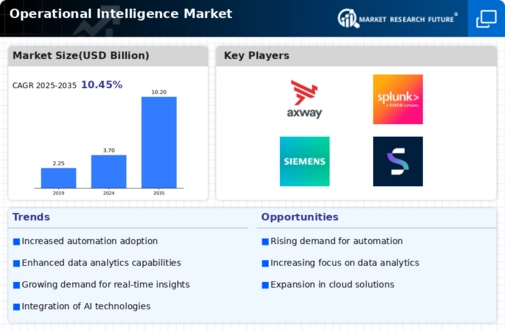-
Executive Summary
-
Scope of the Report
-
Market Definition
-
Scope of the Study
- Research Objectives
- Assumptions & Limitations
-
Markets Structure
-
Market Research Methodology
-
Research Process
-
Secondary Research
-
Primary Research
-
Forecast Model
-
Market Landscape
-
Porter’s Five Forces Analysis
- Threat of New Entrants
- Bargaining power of buyers
- Threat of substitutes
- Segment rivalry
- Bargaining power of suppliers
-
Value Chain/Supply Chain of Global Operational Intelligence Market
-
Industry Overview of Global Operational Intelligence Market
-
Introduction
-
Growth Drivers
-
Impact analysis
-
Market Challenges
-
Market Trends
-
Introduction
-
Growth Trends
-
Impact analysis
-
Global Operational Intelligence Market by Type
-
Introduction
-
Enterprise Manufacturing Operational Intelligence
- Market Estimates & Forecast, 2020-2027
- Market Estimates & Forecast by Region, 2020-2027
-
Enterprise Operational Intelligence Software
- Market Estimates & Forecast, 2020-2027
- Market Estimates & Forecast by Region, 2020-2027
-
IT Service Intelligence
- Market Estimates & Forecast, 2020-2027
- Market Estimates & Forecast by Region, 2020-2027
-
Enterprise Security
- Market Estimates & Forecast, 2020-2027
- Market Estimates & Forecast by Region, 2020-2027
-
Global Operational Intelligence Market by Deployment
-
Introduction
-
Cloud
- Market Estimates & Forecast, 2020-2027
- Market Estimates & Forecast by Region, 2020-2027
-
On Premise
- Market Estimates & Forecast, 2020-2027
- Market Estimates & Forecast by Region, 2020-2027
-
Global Operational Intelligence Market by Application
-
Introduction
-
Supply Chain & Logistics
- Market Estimates & Forecast, 2020-2027
- Market Estimates & Forecast by Region, 2020-2027
-
Assembly Line Quality Assurance
- Market Estimates & Forecast, 2020-2027
- Market Estimates & Forecast by Region, 2020-2027
-
Preventive Maintenance
- Market Estimates & Forecast, 2020-2027
- Market Estimates & Forecast by Region, 2020-2027
-
Exploration & Production Optimization
- Market Estimates & Forecast, 2020-2027
- Market Estimates & Forecast by Region, 2020-2027
-
Smart Meter Analysis
- Market Estimates & Forecast, 2020-2027
- Market Estimates & Forecast by Region, 2020-2027
-
Others
- Market Estimates & Forecast, 2020-2027
- Market Estimates & Forecast by Region, 2020-2027
-
Global Operational Intelligence Market by Vertical
-
Introduction
-
BFSI
- Market Estimates & Forecast, 2020-2027
- Market Estimates & Forecast by Region, 2020-2027
-
Healthcare
- Market Estimates & Forecast, 2020-2027
- Market Estimates & Forecast by Region, 2020-2027
-
Manufacturing
- Market Estimates & Forecast, 2020-2027
- Market Estimates & Forecast by Region, 2020-2027
-
Retail
- Market Estimates & Forecast, 2020-2027
- Market Estimates & Forecast by Region, 2020-2027
-
Automotive
- Market Estimates & Forecast, 2020-2027
- Market Estimates & Forecast by Region, 2020-2027
-
Oil & Gas
- Market Estimates & Forecast, 2020-2027
- Market Estimates & Forecast by Region, 2020-2027
-
Others
- Market Estimates & Forecast, 2020-2027
- Market Estimates & Forecast by Region, 2020-2027
-
Global Operational Intelligence Market by Region
-
Introduction
-
North America
- Market Estimates & Forecast, 2020-2027
- Market Estimates & Forecast by Type, 2020-2027
- Market Estimates & Forecast by Deployment, 2020-2027
- Market Estimates & Forecast by Application, 2020-2027
- Market Estimates & Forecast by Vertical, 2020-2027
- U.S.
- Canada
- Mexico
-
Europe
- Market Estimates & Forecast, 2020-2027
- Market Estimates & Forecast by Type, 2020-2027
- Market Estimates & Forecast by Deployment, 2020-2027
- Market Estimates & Forecast by Application, 2020-2027
- Market Estimates & Forecast by Vertical, 2020-2027
- Germany
- France
- Italy
- Spain
- U.K
-
Asia Pacific
- Market Estimates & Forecast, 2020-2027
- Market Estimates & Forecast by Type, 2020-2027
- Market Estimates & Forecast by Deployment, 2020-2027
- Market Estimates & Forecast by Application, 2020-2027
- Market Estimates & Forecast by Vertical, 2020-2027
- China
- India
- Japan
- Rest of Asia Pacific
-
Rest of the World
- Market Estimates & Forecast, 2020-2027
- Market Estimates & Forecast by Type, 2020-2027
- Market Estimates & Forecast by Deployment, 2020-2027
- Market Estimates & Forecast by Application, 2020-2027
- Market Estimates & Forecast by Vertical, 2020-2027
- The Middle East & Africa
- Latin America
-
Company Landscape
-
Company Profiles
-
OpsVeda, Inc.
- Company Overview
- Product/Business Segment Overview
- Financial Updates
- Key Developments
-
Splunk Inc.
- Company Overview
- Product/Business Segment Overview
- Financial Updates
- Key Developments
-
Siemens AG
- Company Overview
- Product/Business Segment Overview
- Financial Updates
- Key Developments
-
SQLsteam
- Company Overview
- Product/Business Segment Overview
- Financial Updates
- Key Developments
-
Vitria technology, Inc.
- Company Overview
- Product/Business Segment Overview
- Financial Updates
- Key Developments
-
Flexeye Ltd.
- Company Overview
- Product/Business Segment Overview
- Financial Updates
- Key Developments
-
Axway Inc.
- Company Overview
- Product/Business Segment Overview
- Financial Updates
- Key Developments
-
Intelligent InSites, Inc.
- Company Overview
- Product/Business Segment Overview
- Financial Updates
- Key Developments
-
Starview Inc.
- Company Overview
- Product/Business Segment Overview
- Financial Updates
- Key Developments
-
Oversight Systems, Inc.
- Company Overview
- Product/Business Segment Overview
- Financial Updates
- Key Developments
-
Space Time Insight, Inc.
- Company Overview
- Product/Business Segment Overview
- Financial Updates
- Key Developments
-
Software AG
- Company Overview
- Product/Business Segment Overview
- Financial Updates
- Key Developments
-
OpenText Corporation
- Company Overview
- Product/Business Segment Overview
- Financial Updates
- Key Developments
-
VisionWaves B.V.
- Company Overview
- Product/Business Segment Overview
- Financial Updates
- Key Developments
-
Conclusion
-
-
LIST OF TABLES
-
Global Operational Intelligence Market: By Region, 2020-2027
-
North America Operational Intelligence Market: By Country, 2020-2027
-
Europe Operational Intelligence Market: By Country, 2020-2027
-
Asia-Pacific Operational Intelligence Market: By Country, 2020-2027
-
Middle East & Africa Operational Intelligence Market: By Country, 2020-2027
-
Latin America Operational Intelligence Market: By Country, 2020-2027
-
Global Operational Intelligence by Type Market: By Regions, 2020-2027
-
North America Operational Intelligence by Type Market: By Country, 2020-2027
-
Europe Operational Intelligence by Type Market: By Country, 2020-2027
-
Table10 Asia-Pacific Operational Intelligence by Type Market: By Country, 2020-2027
-
Table11 Middle East & Africa Operational Intelligence by Type Market: By Country, 2020-2027
-
Table12 Latin America Operational Intelligence by Type Market: By Country, 2020-2027
-
Table13 Global Operational Intelligence by Deployment Market: By Regions, 2020-2027
-
Table14 North America Operational Intelligence by Deployment Market: By Country, 2020-2027
-
Table15 Europe Operational Intelligence by Deployment Market: By Country, 2020-2027
-
Table16 Asia-Pacific Operational Intelligence by Deployment Market: By Country, 2020-2027
-
Table17 Middle East & Africa Operational Intelligence by Deployment Market: By Country, 2020-2027
-
Table18 Latin America Operational Intelligence by Deployment Market: By Country, 2020-2027
-
Table19 Global Operational Intelligence by Application Market: By Regions, 2020-2027
-
Table20 North America Operational Intelligence by Application Market: By Country, 2020-2027
-
Table21 Europe Operational Intelligence by Application Market: By Country, 2020-2027
-
Table22 Asia-Pacific Operational Intelligence by Application Market: By Country, 2020-2027
-
Table23 Middle East & Africa Operational Intelligence by Application Market: By Country, 2020-2027
-
Table24 Latin America Operational Intelligence by Application Market: By Country, 2020-2027
-
Table25 Global Operational Intelligence by Vertical Market: By Regions, 2020-2027
-
Table26 North America Operational Intelligence by Vertical Market: By Country, 2020-2027
-
Table27 Europe Operational Intelligence by Vertical Market: By Country, 2020-2027
-
Table28 Asia-Pacific Operational Intelligence by Vertical Market: By Country, 2020-2027
-
Table29 Middle East & Africa Operational Intelligence by Vertical Market: By Country, 2020-2027
-
Table30 Latin America Operational Intelligence by Vertical Market: By Country, 2020-2027
-
Table31 Global Deployment Market: By Region, 2020-2027
-
Table32 Global Application Market: By Region, 2020-2027
-
Table33 North America Operational Intelligence Market, By Country
-
Table34 North America Operational Intelligence Market, By Type
-
Table35 North America Operational Intelligence Market, By Deployment
-
Table36 North America Operational Intelligence Market, By Application
-
Table37 North America Operational Intelligence Market, By Vertical
-
Table38 Europe: Operational Intelligence Market, By Country
-
Table39 Europe: Operational Intelligence Market, By Type
-
Table40 Europe: Operational Intelligence Market, By Deployment
-
Table41 Europe: Operational Intelligence Market, By Application
-
Europe: Operational Intelligence Market, By Vertical
-
Table43 Asia-Pacific: Operational Intelligence Market, By Country
-
Table44 Asia-Pacific: Operational Intelligence Market, By Type
-
Asia-Pacific: Operational Intelligence Market, By Deployment
-
Asia-Pacific: Operational Intelligence Market, By Application
-
Asia-Pacific: Operational Intelligence Market, By Vertical
-
Table48 Middle East & Africa: Operational Intelligence Market, By Country
-
Table49 Middle East & Africa Operational Intelligence Market, By Type
-
Table50 Middle East & Africa Operational Intelligence Market, By Deployment
-
Table51 Middle East & Africa: Operational Intelligence Market, By Application
-
Table52 Middle East & Africa: Operational Intelligence Market, By Vertical
-
Table53 Latin America: Operational Intelligence Market, By Country
-
Table54 Latin America Operational Intelligence Market, By Type
-
Table55 Latin America Operational Intelligence Market, By Deployment
-
Table56 Latin America: Operational Intelligence Market, By Application
-
Table57 Latin America: Operational Intelligence Market, By Vertical
-
-
LIST OF FIGURES
-
Global Operational Intelligence Market Segmentation
-
Forecast Methodology
-
Five Forces Analysis of Global Operational Intelligence Market
-
Value Chain of Global Operational Intelligence Market
-
Share of Global Operational Intelligence Market in 2020, by country (in %)
-
Global Operational Intelligence Market, 2020-2027,
-
Sub segments of Type
-
Global Operational Intelligence Market size by Type, 2020
-
Share of Global Operational Intelligence Market by Type, 2020 TO 2027
-
Global Operational Intelligence Market size by Deployment, 2020
-
Share of Global Operational Intelligence Market by Deployment, 2020 TO 2027
-
Global Operational Intelligence Market size by Application, 2020 TO 2027
-
Share of Global Operational Intelligence Market by Application, 2020 TO 2027
-
Global Operational Intelligence Market size by Vertical, 2020 TO 2027
-
Share of Global Operational Intelligence Market by Vertical, 2020 TO 2027


















Leave a Comment